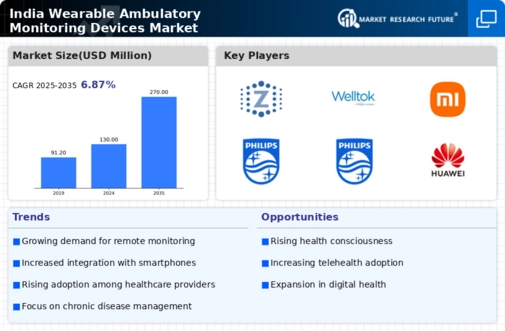Growing Fitness Consciousness
The rising fitness consciousness among the Indian population is a significant driver for the wearable ambulatory-monitoring-devices market. As more individuals prioritize health and wellness, there is an increasing demand for devices that can monitor physical activity, heart rate, and other fitness metrics. The fitness tracker segment, in particular, has seen a surge in popularity, with market reports indicating a growth rate of approximately 30% annually. This trend is further supported by the proliferation of fitness apps and social media platforms that encourage healthy lifestyles. Consequently, the wearable ambulatory-monitoring-devices market is likely to expand as consumers seek tools to help them achieve their fitness goals.
Rising Chronic Disease Prevalence
The increasing prevalence of chronic diseases in India is a pivotal driver for the wearable ambulatory-monitoring-devices market. With conditions such as diabetes, hypertension, and cardiovascular diseases affecting millions, there is a growing demand for continuous health monitoring solutions. According to recent health statistics, approximately 77 million individuals in India are living with diabetes, which necessitates regular monitoring. This trend is likely to propel the adoption of wearable devices that can track vital signs and health metrics in real-time, thereby enabling timely interventions. The wearable ambulatory-monitoring-devices market is expected to witness substantial growth as healthcare providers and patients seek innovative solutions for effective management of chronic conditions.
Aging Population and Healthcare Needs
The aging population in India is a critical driver for the wearable ambulatory-monitoring-devices market. As the demographic shifts towards an older age group, there is a heightened need for healthcare solutions that cater to the unique requirements of elderly individuals. Wearable devices that monitor vital signs, detect falls, and provide emergency alerts are becoming increasingly essential for this demographic. With projections indicating that the elderly population will reach 300 million by 2050, the demand for such monitoring devices is likely to surge. This trend suggests that the wearable ambulatory-monitoring-devices market will experience significant growth as families and healthcare providers seek to ensure the safety and well-being of older adults.
Technological Integration in Healthcare
The integration of advanced technologies into healthcare systems is significantly influencing the wearable ambulatory-monitoring-devices market. Innovations such as artificial intelligence, machine learning, and IoT are enhancing the functionality of wearable devices, making them more efficient and user-friendly. For instance, AI algorithms can analyze data collected from wearables to provide personalized health insights, which is increasingly appealing to consumers. Furthermore, the Indian government is promoting digital health initiatives, which could lead to a projected market growth of around 25% over the next five years. This technological evolution is likely to foster greater acceptance and utilization of wearable devices among healthcare professionals and patients alike.
Government Initiatives for Health Technology
Government initiatives aimed at enhancing healthcare technology are playing a crucial role in the growth of the wearable ambulatory-monitoring-devices market. The Indian government has launched various programs to promote digital health solutions, which include subsidies and incentives for health tech startups. These initiatives are designed to improve access to healthcare and encourage innovation in medical technology. As a result, the market for wearable devices is expected to benefit from increased funding and support, potentially leading to a market expansion of around 20% in the coming years. This supportive environment is likely to attract more players into the wearable ambulatory-monitoring-devices market, fostering competition and innovation.
























Leave a Comment